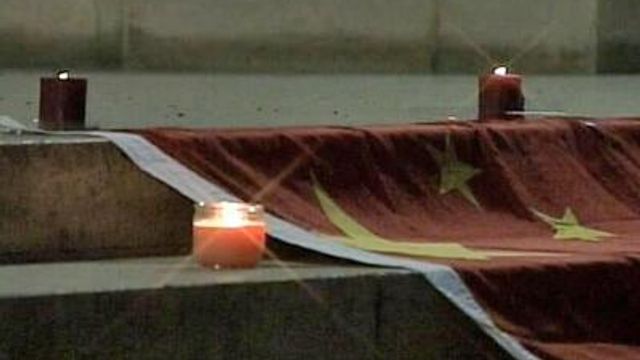World News
As quake toll rises, Triangle gathers to mourn
Duke students and local Chinese groups are collecting monetary donations to help the victims of the 7.9 magnitude earthquake that struck Central China Monday.
Posted — UpdatedDURHAM, N.C. — Chinese students at Duke University held a candlelight vigil Tuesday night to mourn the loss of life in the 7.9-magnitude earthquake that struck in China's Sichuan province early Monday.
The toll of the dead and missing continued to soar Tuesday as rescue workers dug through flattened schools and homes in a desperate attempt to find survivors of the country's worst earthquake in three decades. (View photos of the damage and aftermath.)
The official death toll climbed past 12,000 Tuesday, and that number appeared certain to rise far higher as rescue and recovery efforts moved forward.
The vigil, in front of Duke Chapel, was open to the public, and organizers encouraged those who came to wear black. Members of the DukeChinese Students and Scholars Association planned to lead the assembly in prayers and accept donations toward relief efforts.
Other local groups, including the local chapter of the Chinese-American Friendship Association and the Triangle-Area Chinese American Society, are also organizing relief efforts and collecting donations.
China's state-run Xinhua News Agency said 18,645 people were still buried in debris in and around Mianyang, a city about 60 miles east of the epicenter. People there spent a second night sleeping outside in the rain, some under striped plastic sheeting after the government ordered people not to return to their homes, citing safety concerns.
"My heart was so uneasy last night, I couldn't sleep," said Wen Dajian, wrapped in a floral quilt lying on the rickshaw he uses to make a living hauling goods. "I'm still so scared tonight. There's no place for me to go."
The Sichuan Daily newspaper reported on its Web site that more than 26,000 people were injured in the Mianyang area.
More than two dozen British and American tourists who were thought to be panda-watching in the area also remained missing.
Officials urged the public not to abandon hope.
"Survivors can hold on for some time. Now, it's not time to give up," Wang Zhenyao, disaster relief division director at the Ministry of Civil Affairs, told reporters in Beijing.
State media said rescue workers had reached the epicenter in Wenchuan county – where the number of casualties was still unknown. The quake was centered just north of the Sichuan provincial capital of Chengdu in central China, tearing into urban areas and mountain villages.
Some 20,000 soldiers and police arrived in the disaster area, and 30,000 more were on their way by plane, train, trucks and even on foot, the Defense Ministry told Xinhua.
Aftershocks rattled the region for a second day, sending people running into the streets in Chengdu. The U.S. Geological Survey measured the shocks between magnitude 4 and 6, some of the strongest since Monday's quake.
Expressions of sympathy and offers of help poured in from the United States, Japan and the European Union, among others.
The Chinese government said it would welcome outside aid, and Russia was sending a plane with rescuers and supplies, that country's Interfax news agency reported.
But Wang, the disaster relief official, said international aid workers would not be allowed to travel to the affected area.
"We welcome funds and supplies; we can't accommodate personnel at this point," he said.
China's Ministry of Finance said it had allocated $123 million in aid for quake-hit areas.
The quake was China's deadliest since 1976, when 240,000 people were killed in the city of Tangshan, near Beijing. Financial analysts said the quake would have only a limited impact on the country's booming economy.
Copyright 2024 by WRAL.com and the Associated Press. All rights reserved. This material may not be published, broadcast, rewritten or redistributed.





